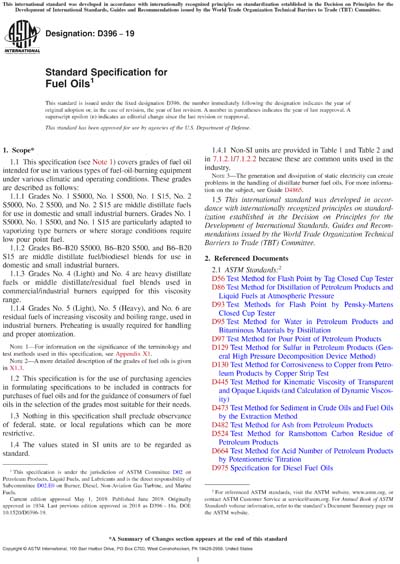Historical
ASTM D396-19
Standard Specification for Fuel Oils
1.1 This specification (see Note 1) covers grades of fuel oil intended for use in various types of fuel-oil-burning equipment under various climatic and operating conditions. These grades are described as follows:
1.1.1 Grades No. 1 S5000, No. 1 S500, No. 1 S15, No. 2 S5000, No. 2 S500, and No. 2 S15 are middle distillate fuels for use in domestic and small industrial burners. Grades No. 1 S5000, No. 1 S500, and No. 1 S15 are particularly adapted to vaporizing type burners or where storage conditions require low pour point fuel.
1.1.2 Grades B6–B20 S5000, B6–B20 S500, and B6–B20 S15 are middle distillate fuel/biodiesel blends for use in domestic and small industrial burners.
1.1.3 Grades No. 4 (Light) and No. 4 are heavy distillate fuels or middle distillate/residual fuel blends used in commercial/industrial burners equipped for this viscosity range.
1.1.4 Grades No. 5 (Light), No. 5 (Heavy), and No. 6 are residual fuels of increasing viscosity and boiling range, used in industrial burners. Preheating is usually required for handling and proper atomization.
Note 1: For information on the significance of the terminology and test methods used in this specification, see Appendix X1.
Note 2: A more detailed description of the grades of fuel oils is given in X1.3.
1.2 This specification is for the use of purchasing agencies in formulating specifications to be included in contracts for purchases of fuel oils and for the guidance of consumers of fuel oils in the selection of the grades most suitable for their needs.
1.3 Nothing in this specification shall preclude observance of federal, state, or local regulations which can be more restrictive.
1.4 The values stated in SI units are to be regarded as standard.
1.4.1 Non-SI units are provided in Table 1 and Table 2 and in 7.1.2.1/7.1.2.2 because these are common units used in the industry.
Note 3: The generation and dissipation of static electricity can create problems in the handling of distillate burner fuel oils. For more information on the subject, see Guide D4865.
1.5 This international standard was developed in accordance with internationally recognized principles on standardization established in the Decision on Principles for the Development of International Standards, Guides and Recommendations issued by the World Trade Organization Technical Barriers to Trade (TBT) Committee.
Content Provider
ASTM International [astm]






